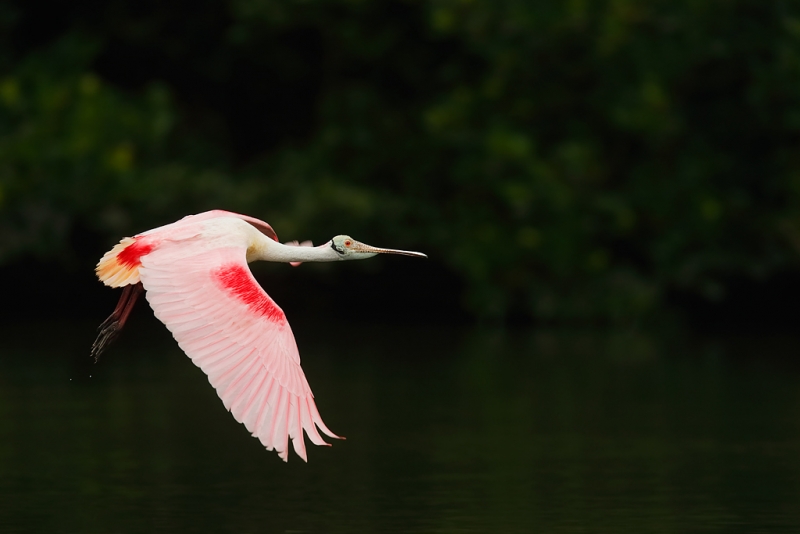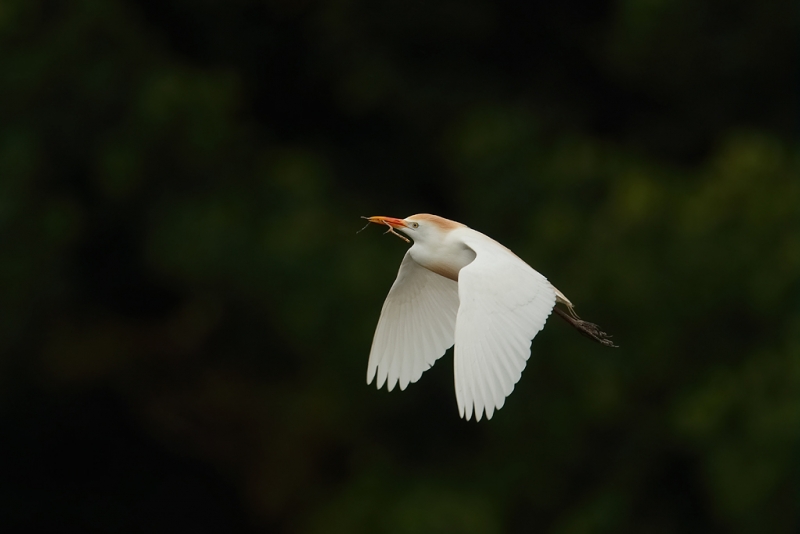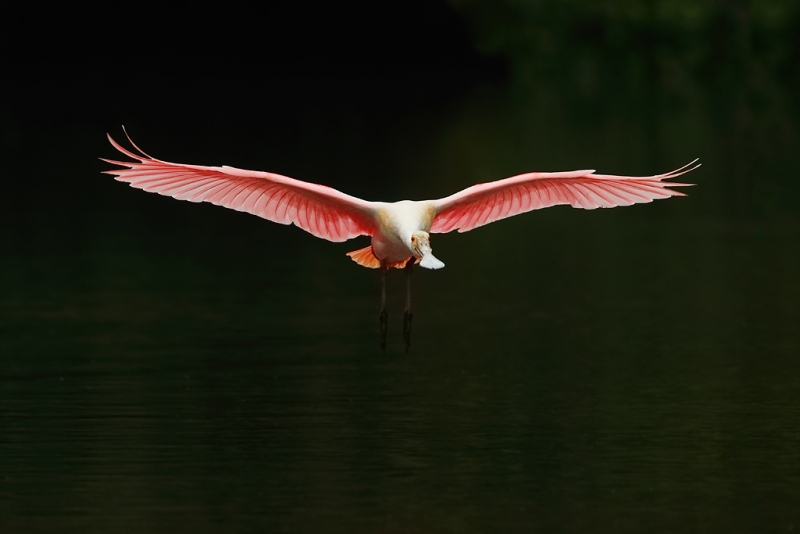|
This Roseate Spoonbill flight image was created at Alafia Banks on the Fort Desoto/Hooptie Deux IPT on the rain-soaked Thursday morning Hooptie trip with the tripod-mounted Canon EF 600mm f/4L IS II USM lens, the Canon 2x EF Extender III (Teleconverter), and the Canon EOS-1D X Digital SLR camera. ISO 1600. Evaluative metering -1 2/3 stops as framed: 1/640 sec. at f/8 in Manual Mode; exposure confirmed on resting spoonbills via histogram check. Central sensor (by necessity) Expand/AI Servo/Rear Focus AF on the bird’s neck active at the moment of exposure. Click here if you missed the Rear Focus Tutorial. Click on the image to see a larger version. If you want spoonbills you need to get yourself on the Hooptie Deux. Canon users cannot beat the 600II/2XIII TC combo for reach (with phase detection AF). |
1200mm Flight Photography in the Dark: Tips
Wide Open
Click here and scroll down to item 3 if you missed the details of the very rainy IPT morning.
We had some spoonbills in the lee of some mangroves when more began to fly in. It was pretty darned dark. I went with 1/640 sec. at f/8, ISO 1600 rather than 1/1250 sec. at f/8 at ISO 3200. Note that working wide open was the way to go as with the birds at a distance depth-of-field was not an issue.
|
Same place, same time. This Cattle Egret carrying nesting material was photographed with the tripod-mounted Canon EF 600mm f/4L IS II USM lens, the Canon 2x EF Extender III (Teleconverter), and the Canon EOS-1D X Digital SLR camera. ISO 1600: 1/1000 sec. at f/8 in Manual Mode; exposure confirmed on resting White Ibises via histogram check. Central sensor (by necessity) Expand/AI Servo/Rear Focus AF on the bird’s neck active at the moment of exposure. Click here if you missed the Rear Focus Tutorial. Click on the image to see a larger version. |
Pre-focus Manually
It is imperative when shooting flight with an f/4 super-telephoto and a 2X TC that you pre-focus manually by turning the focus ring before engaging AF. For me, that means to pre-focus before hitting the back button.
|
This incoming Roseate Spoonbill image was also created at Alafia Banks on the Fort Desoto/Hooptie Deux IPT on the rain-soaked Thursday morning Hooptie trip with the tripod-mounted Canon EF 600mm f/4L IS II USM lens, the Canon 2x EF Extender III (Teleconverter), and the Canon EOS-1D X Digital SLR camera. ISO 1600: 1/800 sec. at f/8 in Manual Mode; exposure previously confirmed on resting spoonbills via histogram check. Central sensor (by necessity) Expand/AI Servo/Rear Focus AF on the bird’s neck active at the moment of exposure. Click here if you missed the Rear Focus Tutorial. Click on the image to see a larger version. If you want spoonbills you need to get yourself on the Hooptie Deux. Canon users cannot beat the 600II/2XIII TC combo for reach (with phase detection AF). |
Lens Drive When AF Impossible
You will find Lens Drive When AF Impossible on the fourth Purple menu, AF 4. The big problem is that folks simply have no clue how to set this for normal shooting and how to set it for flight photography. And to make matters worse, the Info tutorials on the camera are quite confusing at best. Setting Lens Drive When AF Impossible correctly when using the 2X II TC for flight photography is of paramount importance. To learn when and why to set this to Continue Focus Search ON and when and why to set it to Stop Focus Search: OFF, see page 27 of the EOS-1D X AF Guide and/or pages 32 and 33 of the EOS-5D Mark III User’s Guide.
Surface Blur
Each of the images above was converted in DPP with Chrominance Noise Reduction set to 16. Image/Blur/Surface blur as taught to me by Denise Ippolito and as detailed in Digital Basics, did a great job of smoothing the dark, ISO 1600 backgrounds.
Digital Basics includes my complete digital workflow, dozens of great Photoshop tips and techniques, all of my time-saving Keyboard Shortcuts, Quick Masking, Layer Masking, and NIK basics, and free updates. Learn how and why I am converting all of my images in Canon DPP (Digital Photo Professional) in our DPP RAW Conversion Guide here.
Which is Your Favorite Image?
Take a moment to leave a comment and let us know which is your favorite image. And why. Which is your least favorite? Why?
Typos
On all blog posts, feel free to e-mail or leave a comment regarding any typos, wrong words, misspellings, omissions, or grammatical errors. Just be right. 🙂
Support the BAA Blog. Support the BAA Bulletins: Shop B&H here!
We want and need to keep providing you with the latest free information, photography and Photoshop lessons, and all manner of related information. Show your appreciation by making your purchases immediately after clicking on any of our B&H or Amazon Affiliate links in this blog post. Remember, B&H ain’t just photography!




Support the BAA Blog. Support the BAA Bulletins: Shop Amazon here!
And from the BAA On-line Store:
LensCoats. I have a LensCoat on each of my big lenses to protect them from nicks and thus increase their re-sales value. All my big lens LensCoat stuff is in Hardwood Snow pattern.
LegCoat Tripod Leg Covers. I have four tripods active and each has a Hardwood Snow LegCoat on it to help prevent further damage to my tender shoulders :) And you will love them in mega-cold weather....
Gitzo GT3532 LS CF Tripod. This one replaces the GT3530LS Tripod and will last you a lifetime. Learn more about this great tripod here.
Mongoose M3.6 Tripod Head. Right now this is the best tripod head around for use with lenses that weigh less than 9 pounds. For heavier lenses, check out the Wimberley V2 head.
Double Bubble Level. You will find one in my camera's hot shoe whenever I am not using flash.
The Lens Align Mark II. I use the Lens Align Mark II pretty much religiously to micro-adjust all of my gear an average of once a month and always before a major trip. Enjoy our free comprehensive tutorial here.
BreezeBrowser. I do not see how any digital photographer can exist without this program.
Delkin Flash Cards. I use and depend on Delkin compact Flash Cards and card readers most every day. Learn more about their great 700X and 1000X cards here or about my favorite Delkin card here.

















Many thanks to all for their kind comments. The key is knowing how to use Focus Search On or Off. BTW, the new EOS-5D Mark III firmware is now supposed to be out in May….
Great photos, Artie. The third is my favorite, because of the unusual shot of the bird flying right at you, the symmetry, the color; then the first. The egret is great but I just love spoonbills. Your blogs are great tutorials in the importance of exposure and composition! And everything else.
Very Skillful & Amazing work both behind the lens and post-processing Artie. I think I’m dreadfully reluctant to attempt ISO’s that high on my pro-sumer 7D, 800 has always been about the highest I will go. Seeing that you used the chrominance noise reduction at 16 in DPP, along with the surface blur background makes me wonder if I should crank it up a bit. I have the DPP RAW Conversion guide but always avoided using iso’s like 1600. Hopefully one day that will change when I aquire a Pro-body but if there skills I can practice now even better. I see the work Arash does or even Alan Murphy at extreme iso’s and blown away, and now you as well. I favor the challenge you had of the incoming Spoonbill, at 1200mm in low light. Awesome job Artie.
Beautiful lighting and contrast with some detail left in the dark background. Would chose #3 as favorite. The contrast , lighting, symmetry, and detail is spectacular.
Least favorite?…maybe #1 as it is merely perfect…
The dull, rainy conditions has actually produced superb soft lighting on the bird’s bright plumage giving a real three dimensional feel. Even using a tripod it’s great to be able to pick up and hold onto the flying bird using 1200mm of focal length!! but the contrast between the birds and the dark BG. enabled the excellent auto focussing of the 1DX to work as efficiently as possible without BG distraction. My Favourite? the Cattle Egret – v.g. wing positions, lovely soft three dimensional lighting and the added interest with the bird carrying nesting material. The Spoonbills are very dramatic but I can remember even better ones from you Art.
That is an amazing skill to be able to pick up the birds in flight and get the the bird in the focal plane at 1200mm which is a very limited field of view. You make it look easy – but it isn’t.